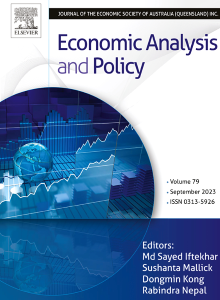Vietnam's exports to Korea and the real exchange rate: Post-crisis evidence from the multiple threshold nonlinear autoregressive distributed lag model
IF 7.9
2区 经济学
Q1 ECONOMICS
引用次数: 0
Abstract
In this study, the asymmetric effects of the real exchange rate on Vietnam's exports to Korea were investigated using the multiple threshold nonlinear autoregressive distributed lag (MTNARDL) model. As a result, the MTNARDL model exhibited enhanced estimation accuracy compared to the single-threshold nonlinear autoregressive distributed lag (NARDL) model. Furthermore, the aggregate bias problem was solved using individual export data for 16 major industries instead of relying on the overall export value data. The results revealed the substantial asymmetric impact of real exchange rate fluctuations in the short and long run. Fluctuations in the real exchange rate boosted Vietnam's exports to the Republic of Korea in the long run, with minimal negative influence. This indicates that the depreciation of the Vietnamese dong against the United States (US) dollar encouraged exports in some industries but limited exports in others. However, the short-term effect of the real exchange rate remains uncertain, as it could be either negative or positive depending on the industry and threshold level. The diverse impacts of the real exchange rate fluctuations on exports across industries were attributed to factors such as the capacity to absorb foreign exchange risks, product heterogeneity, and the ease of adjusting inputs and production for each sector. Therefore, these findings may help policymakers develop Vietnam-specific policies to address long- and short-term changes in the threshold levels of real exchange rate fluctuations.
越南对韩国的出口和实际汇率:来自多阈值非线性自回归分布滞后模型的危机后证据
本研究使用多阈值非线性自回归分布滞后(MTNARDL)模型研究了实际汇率对越南对韩国出口的非对称影响。结果表明,与单阈值非线性自回归分布滞后(NARDL)模型相比,MTNARDL 模型显示出更高的估计精度。此外,利用 16 个主要行业的单个出口数据,而不是依赖整体出口额数据,解决了总体偏差问题。结果表明,实际汇率波动在短期和长期都会产生巨大的非对称影响。从长期来看,实际汇率的波动促进了越南对韩国的出口,而负面影响则微乎其微。这表明越南盾对美元贬值鼓励了某些行业的出口,但限制了其他行业的出口。然而,实际汇率的短期影响仍不确定,因为根据行业和门槛水平的不同,它可能是负面的,也可能是正面的。实际汇率波动对各行业出口的不同影响可归因于吸收外汇风险的能力、产品异质性以及各行业调整投入和生产的难易程度等因素。因此,这些研究结果可能有助于决策者制定针对越南的政策,以应对实际汇率波动临界值的长期和短期变化。
本文章由计算机程序翻译,如有差异,请以英文原文为准。
求助全文
约1分钟内获得全文
求助全文
来源期刊

Economic Analysis and Policy
ECONOMICS-
CiteScore
9.80
自引率
9.20%
发文量
231
审稿时长
93 days
期刊介绍:
Economic Analysis and Policy (established 1970) publishes articles from all branches of economics with a particular focus on research, theoretical and applied, which has strong policy relevance. The journal also publishes survey articles and empirical replications on key policy issues. Authors are expected to highlight the main insights in a non-technical introduction and in the conclusion.
 求助内容:
求助内容: 应助结果提醒方式:
应助结果提醒方式:


